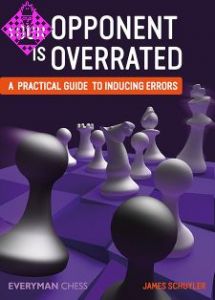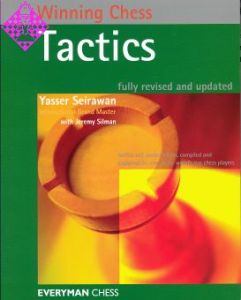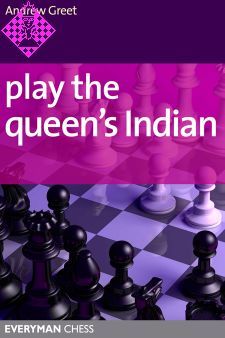Article Number
LOGREPTQI
Author
Play the Queen's Indian
256 pages, paperback, Everyman, 1. edition 2009
The Queen's Indian is a dynamic and flexible way to meet 1 d4. Using Nimzowitsch's principles, Black adopts the hypermodern plan of controlling the centre with pieces rather than the traditional idea of pawn occupation, and this approach often leads to complex and intricate positions rich in ideas both sides. Such is the high regard for the Queen's Indian that virtually all the world's top players have utilized it at one time or another.
In this book Andrew Greet presents a complete repertoire for Black in the Queen's Indian. He reveals his secrets from years of experience in the opening, offers answers for Black against all of White's tries for an advantage, and highlights the principal tactical and positional plans for both White and Black. This book tells you everything you need to know to play the Queen's Indian with confidence in your own games.
PrefaceGreetings, dear reader, and thank you for taking the time to read this book. The aim of this brief introduction is to set the scene for the remainder of the work by providing some relevant background information to our subject, as well explainthe ethos behind the proposed repertoire.
Whilst I hope and, indeed, expect this book to prove useful for players of a wide range of abilities, I would expect most readers to possess some basic knowlof the fundamental principles underlying this opening. Therefore I have no intention to waste time by expounding such concepts as 'controlling the central squares with pieces rather than pawns', and so on. Countless other authors have elucidated the principles and historical development of hypermodern chess theand I will say no more about the subject here.
As is customary for the 'Play the ...' series, the primary aim of the present book is to provide a complete repertoire that will enable the reader to employ the Queen's Indian Defence with confidence. It is common knowledge that, along with its close relative the Nimzo-Indian, the Queen's Indian enjoys a reputation as one of Black's most dependable answers to 1 d4. His pieces can quickly emerge on to active squares, and his pawn structure is both unblemished and extremely flexible in the early stages of the game.
Despite its ongoing popularity amongst players of varying abilities, there are many who regard one of this opening's foremost strengths - its extreme solidity - as something of a drawback. Simply put, there are several major lines in which it can prove difficult for Black to generate realistic winning chances. This may not represent a problem at the lofty heights of Wijk aan Zee or Linares, but there is no doubting the fact that most of us would prefer to combine solidity with genuine prospects to play for a full point with the black pieces. Therefore one of my primary goals in writing this book was to present a repertoire which would enable Black to unbalance the game in order to play for a win, without compromising on soundness.
Overall, I believe that I have succeeded in finding a suitable balance, although ultimately this is something that the reader will have to judge for himself. On that note, let me once again thank you for reading. I sincerely hope that you will enjoy this book, and that the ideas contained herewith will play a role in improving your understanding, enjoyment and - most importantly of all - your results when playing the Queen's Indian.
Andrew Greet
Edinburgh
January 2009
In this book Andrew Greet presents a complete repertoire for Black in the Queen's Indian. He reveals his secrets from years of experience in the opening, offers answers for Black against all of White's tries for an advantage, and highlights the principal tactical and positional plans for both White and Black. This book tells you everything you need to know to play the Queen's Indian with confidence in your own games.
·
Coverage of a popular opening
·
Written by a well-known Queen's Indian expert
·
Contains deep explanations and original analysis
Andrew Greet is an International Master, a former British Junior Champion, and is one of the UK's most rapidly improving players. In 2005 he scored a perfect 11/11 in the British National League, the first time any player had achieved this remarkable feat. His first book for Everyman Chess, Play the Ruy Lopez, has been widely praised for its depth and original analysis.PrefaceGreetings, dear reader, and thank you for taking the time to read this book. The aim of this brief introduction is to set the scene for the remainder of the work by providing some relevant background information to our subject, as well explainthe ethos behind the proposed repertoire.
Whilst I hope and, indeed, expect this book to prove useful for players of a wide range of abilities, I would expect most readers to possess some basic knowlof the fundamental principles underlying this opening. Therefore I have no intention to waste time by expounding such concepts as 'controlling the central squares with pieces rather than pawns', and so on. Countless other authors have elucidated the principles and historical development of hypermodern chess theand I will say no more about the subject here.
As is customary for the 'Play the ...' series, the primary aim of the present book is to provide a complete repertoire that will enable the reader to employ the Queen's Indian Defence with confidence. It is common knowledge that, along with its close relative the Nimzo-Indian, the Queen's Indian enjoys a reputation as one of Black's most dependable answers to 1 d4. His pieces can quickly emerge on to active squares, and his pawn structure is both unblemished and extremely flexible in the early stages of the game.
Despite its ongoing popularity amongst players of varying abilities, there are many who regard one of this opening's foremost strengths - its extreme solidity - as something of a drawback. Simply put, there are several major lines in which it can prove difficult for Black to generate realistic winning chances. This may not represent a problem at the lofty heights of Wijk aan Zee or Linares, but there is no doubting the fact that most of us would prefer to combine solidity with genuine prospects to play for a full point with the black pieces. Therefore one of my primary goals in writing this book was to present a repertoire which would enable Black to unbalance the game in order to play for a win, without compromising on soundness.
Overall, I believe that I have succeeded in finding a suitable balance, although ultimately this is something that the reader will have to judge for himself. On that note, let me once again thank you for reading. I sincerely hope that you will enjoy this book, and that the ideas contained herewith will play a role in improving your understanding, enjoyment and - most importantly of all - your results when playing the Queen's Indian.
Andrew Greet
Edinburgh
January 2009
| EAN | 9781857445800 |
|---|---|
| Weight | 380 g |
| Manufacturer | Everyman |
| Width | 15.2 cm |
| Height | 22.8 cm |
| Medium | Book |
| Year of Publication | 2009 |
| Author | Andrew Greet |
| Language | English |
| Edition | 1 |
| ISBN-13 | 9781857445800 |
| Pages | 256 |
| Binding | paperback |
004 Bibliography
005 Preface
007 Early Bishop Developments
019 The Straightforward 4.e3
036 The Hybrid System: 4.Nf3 Bb4
049 The Hybrid System: 5.e3
058 The Hybrid System: 5.Qb3!?
079 The Hybrid System: 5.Bg5
090 The Main Line Hybrid: 5.Bg5 with 9.e3
112 The Petrosian Variation: 4.a3 Ba6
120 The Petrosian Variation: 5.e3
129 The Petrosian Variation: 5.Qc2
147 The Petrosian Main Line: 10.Bf4 & 10.Bg5
169 The Fianchetto Variation: 4.g3 Ba6
185 The Fianchetto Variation: 5.Qa4
206 The Fianchetto Variation: 5.Qc2!?
227 The Fianchetto Variation: 5.b3
232 The Fianchetto Variation: 5.b3 b5!? 6.cxb5
250 Index of Variations
005 Preface
007 Early Bishop Developments
019 The Straightforward 4.e3
036 The Hybrid System: 4.Nf3 Bb4
049 The Hybrid System: 5.e3
058 The Hybrid System: 5.Qb3!?
079 The Hybrid System: 5.Bg5
090 The Main Line Hybrid: 5.Bg5 with 9.e3
112 The Petrosian Variation: 4.a3 Ba6
120 The Petrosian Variation: 5.e3
129 The Petrosian Variation: 5.Qc2
147 The Petrosian Main Line: 10.Bf4 & 10.Bg5
169 The Fianchetto Variation: 4.g3 Ba6
185 The Fianchetto Variation: 5.Qa4
206 The Fianchetto Variation: 5.Qc2!?
227 The Fianchetto Variation: 5.b3
232 The Fianchetto Variation: 5.b3 b5!? 6.cxb5
250 Index of Variations
Damenindisch kann spannend sein
Damenindisch ist ja sooo langweiMuss es aber nicht! Das zu zeigen ist Andrew Greet in diesem Buch gut gelungen. Außerdem ist die Darstellung der Varianten anasolide und sein vorgestellSchwarzrepertoire gut durchSo weicht er etwa der moabsolut angesagten, für Schwarz aber nach aktuellem Stand der Theorie nicht ungefährBauernopfervariante 1. d4 Sf6 2. c4 e6 3. Sf3 b6 4. g3 La6 5. Dc2 c5 6. d5 exd5 7. cxd5 Lb7 8. Lg2 aus und bietet stattdessen die zuverlässige Alternative 5.... Lb4+ 6. Ld2 Le7 an, untermauert mit nützlichen strategischen Erklärunund gewissenhaften Analywobei hier und im gesamten Buch viel Eigenarbeit eingeflosist.
Das Repertoire gegen das Petrosjan-System (4. a3) und das Hybrid-System (4. Sc3, „Hybrid", weil es ein Mischsystem zwischen Damen- und Nimzowitschindisch erlaubt) ist aufeinander abgestimmt: Ge4. a3 spielt Greet das aktivere 4.... La6 (statt des soliden 4.... Lb7), während er gegen 4. Sc3 folge4.... Lb4 zieht (die Alterna4. ... Lb7 hätte Weiß nämlich mit 5. a3 den Übergang in die Lb7-Variante des Petrosjan-Systems geBeide Systeme bieten lebSpiel, wie man es meist nicht mit Damenindisch verbindet.
Eine härtere Nuss ist aber die „ulHauptfortsetzung 4. g3 La6 5. b3. Greet schlägt hier 5. ... b5!? vor. Dieser Zug ist zwar schon länger bekannt, aber nie so richtig in Mode gekommen. Der Autor baut auch hier ein interessantes und gut spielbares Repertoire auf, erreicht aber gegen das hyper4. g3 nicht ganz das lebhafSpiel wie in den anderen VariAus meiner eigenen Praxis kann ich aus dem Finale des ICCF-E-Mail-Jubiläumsturniers die ParLins - Kögler (Fernpartie 2009) beisteuern: (1. d4 Sf6 2. c4 e6 3. Sf3 b6 4. g3 La6 5. b3 b5) 6. cxb5 Lxb5 7. Lg2 d5 8. 0-0 Sbd7 9. Sc3 La6 10. Tel Lb4 11. Dc2!? (Greet benur 11. Ld2 und 11. Lb2) 11....c5! (besser als 11....0-0, weil Schwarz nach 12. a3! nebst Sa4 - auf c3 zu tauschen ist hier schlech- Schwierigkeiten hat, den weißen Druck auf dem Damenügel abzuschütteln) 12. a3 Lxc3 13. Dxc3 Se4 14. Dc2. Schwarz hielt mit 14. ... c4! das Zentrum geschlossen, wonach Weiß etwas angenehmer stand, Schwarz dagegen mit seiner soliStellung auch zufrieden war. Nicht nur dieses Beispiel zeigt: Wenn Weiß in der 4. g3-Variante umsichtig spielt und nicht viel riswill, dann kann man als Schwarzer auch nicht mit Gewalt Wunder wirken. Greet beschäfsich mit dieser Problematik im Abspiel 1. d4 Sf6 2. c4 e6 3. Sf3 b6 4. g3 La6 5. Da4 Lb7 6. Lg2 c5 7.0-0 cxd4 8. Sxd4 Lxg2 9. Kxg2 Dc8 10. Sc3 (10. Lf4 ist aktiver und erält von Greet den Status als Haupt10.... Sc6 11. Sxc6 Dxc6+ 12. Dxc6 bxc6, die er mit „dry equality" (also etwa „voller Ausin langweiliger Position") beurteilt. Er gibt dort den wertTipp, dass man auch solche Stellungen mit Entschlossenheit weiterspielen sollte, wenn man wirklich gewinnen will. Immerhin kann man argumentieren, dass Schwarz eine gewisse psychologiInitiative besitzt, wenn der Weiße nicht mehr als diese Stelaus der Eröffnung herausgehat. Die Existenz solcher Vabegeistert vielleicht nicht jeden potenziellen Schwarzaber er ist damit erheblich besser bedient als mit dem Vorvon interessanten Opferdie im Praxistest dann zwar viel Spaß machen, aber meist leider dem Gegner.
Insgesamt ist Andrew Greet ein sehr gutes Eröffnungsbuch geIn vielen Varianten zeigt er, dass auch Damenindisch zu spannendem Spiel führen kann, aber auch dort, wo die Positionen ruhiger bleiben, kann sich der Schwarze auf ein stabiles Reperverlassen, das ihm gute Diensleisten kann. Hervorzuheben ist nochmals die Menge an eigeAnalysen und strategischen Erläuterungen, die Greet beigehat. So stelle ich mir ein Eröffnungsbuch vor: Gute Darstelder aktuellen Theorie plus Eigenleistung. Ob der Leser an den entstehenden Stellungstypen dann auch Gefallen findet, muss er natürlich selber entscheiden.
Mit freundlicher Genehmigung
Klaus Kögler, Kaissiber 34**********Die Damenindische Verteidigung erfreut sich schon seit Jahren großer Beliebtheit unter den Schwarzspielern, nicht zu Unrecht da damit solide und sichere Stellungen herbeigeführt werden können die zudem auch noch gute Chancen auf Gegenspiel versprechen. Der britische IM Andrew Greet hat sich damit näher befasst und ein Repertoirebuch Damenindisch für Schwarz geschrieben.
Auf insgesamt 256 Seiten und 16 Kapitel stellt Greet sein Repertoire vor und teilt das vorhandene Material wie folgt auf:
1.d4 Sf6 2.c4 e6 3.Sf3 b6 4.g3 [4.Lf4; 4.Lg5; 4.Sc3 Lb4; 4.a3 La6; 4.e3 Lb7 5.Sc3 (5.Ld3 d5) 5...d5] 4...La6.
Die populärste (und gefährlichste) Variante dürfte 1.d4 Sf6 2.c4 e6 3.Sf3 b6 4.g3 La6 5.b3 sein, hier schlägt der Autor den relativ neuen Zug 5…b5!? vor, danach geht es weiter mit 6.cxb5 Lxb5 7.Lg2 d5 8.0-0 Sbd7 9.Sc3 La6 10.Se5 und nun der (fast) unbekannte Zug 10… c6! der Schwarz gleiches Spiel sichern dürfte.
Auch in den anderen Abspielen hat sich der Autor um eine individuelle Note bemüht, immer sachlich und objektiv analysiert er die Varianten und reichert diese mit vielen, teilweise unbekannten Ideen, an. Das Buch hinterließ bei mir einen sehr guten Eindruck, die Analysen scheinen sorgfältig geprüft worden zu sein, Fehler oder Unterlassungen hinsichtlich kritischer Abspiele konnte ich nicht finden. Positiv vermerken möchte ich auch, dass Greet die entstehenden Stellungen realistisch einschätzt und den Leser nicht mit einer schwammigen Erklärung am Ende einer Variante alleine lässt. Das Buch kann uneingeschränkt empfohlen werden zum Aufbau eines Damenindisch-Repertoires.
Mit freundlicher Genehmigung
Martin Rieger, www.freechess.info
Februar 2009
Damenindisch ist ja sooo langweiMuss es aber nicht! Das zu zeigen ist Andrew Greet in diesem Buch gut gelungen. Außerdem ist die Darstellung der Varianten anasolide und sein vorgestellSchwarzrepertoire gut durchSo weicht er etwa der moabsolut angesagten, für Schwarz aber nach aktuellem Stand der Theorie nicht ungefährBauernopfervariante 1. d4 Sf6 2. c4 e6 3. Sf3 b6 4. g3 La6 5. Dc2 c5 6. d5 exd5 7. cxd5 Lb7 8. Lg2 aus und bietet stattdessen die zuverlässige Alternative 5.... Lb4+ 6. Ld2 Le7 an, untermauert mit nützlichen strategischen Erklärunund gewissenhaften Analywobei hier und im gesamten Buch viel Eigenarbeit eingeflosist.
Das Repertoire gegen das Petrosjan-System (4. a3) und das Hybrid-System (4. Sc3, „Hybrid", weil es ein Mischsystem zwischen Damen- und Nimzowitschindisch erlaubt) ist aufeinander abgestimmt: Ge4. a3 spielt Greet das aktivere 4.... La6 (statt des soliden 4.... Lb7), während er gegen 4. Sc3 folge4.... Lb4 zieht (die Alterna4. ... Lb7 hätte Weiß nämlich mit 5. a3 den Übergang in die Lb7-Variante des Petrosjan-Systems geBeide Systeme bieten lebSpiel, wie man es meist nicht mit Damenindisch verbindet.
Eine härtere Nuss ist aber die „ulHauptfortsetzung 4. g3 La6 5. b3. Greet schlägt hier 5. ... b5!? vor. Dieser Zug ist zwar schon länger bekannt, aber nie so richtig in Mode gekommen. Der Autor baut auch hier ein interessantes und gut spielbares Repertoire auf, erreicht aber gegen das hyper4. g3 nicht ganz das lebhafSpiel wie in den anderen VariAus meiner eigenen Praxis kann ich aus dem Finale des ICCF-E-Mail-Jubiläumsturniers die ParLins - Kögler (Fernpartie 2009) beisteuern: (1. d4 Sf6 2. c4 e6 3. Sf3 b6 4. g3 La6 5. b3 b5) 6. cxb5 Lxb5 7. Lg2 d5 8. 0-0 Sbd7 9. Sc3 La6 10. Tel Lb4 11. Dc2!? (Greet benur 11. Ld2 und 11. Lb2) 11....c5! (besser als 11....0-0, weil Schwarz nach 12. a3! nebst Sa4 - auf c3 zu tauschen ist hier schlech- Schwierigkeiten hat, den weißen Druck auf dem Damenügel abzuschütteln) 12. a3 Lxc3 13. Dxc3 Se4 14. Dc2. Schwarz hielt mit 14. ... c4! das Zentrum geschlossen, wonach Weiß etwas angenehmer stand, Schwarz dagegen mit seiner soliStellung auch zufrieden war. Nicht nur dieses Beispiel zeigt: Wenn Weiß in der 4. g3-Variante umsichtig spielt und nicht viel riswill, dann kann man als Schwarzer auch nicht mit Gewalt Wunder wirken. Greet beschäfsich mit dieser Problematik im Abspiel 1. d4 Sf6 2. c4 e6 3. Sf3 b6 4. g3 La6 5. Da4 Lb7 6. Lg2 c5 7.0-0 cxd4 8. Sxd4 Lxg2 9. Kxg2 Dc8 10. Sc3 (10. Lf4 ist aktiver und erält von Greet den Status als Haupt10.... Sc6 11. Sxc6 Dxc6+ 12. Dxc6 bxc6, die er mit „dry equality" (also etwa „voller Ausin langweiliger Position") beurteilt. Er gibt dort den wertTipp, dass man auch solche Stellungen mit Entschlossenheit weiterspielen sollte, wenn man wirklich gewinnen will. Immerhin kann man argumentieren, dass Schwarz eine gewisse psychologiInitiative besitzt, wenn der Weiße nicht mehr als diese Stelaus der Eröffnung herausgehat. Die Existenz solcher Vabegeistert vielleicht nicht jeden potenziellen Schwarzaber er ist damit erheblich besser bedient als mit dem Vorvon interessanten Opferdie im Praxistest dann zwar viel Spaß machen, aber meist leider dem Gegner.
Insgesamt ist Andrew Greet ein sehr gutes Eröffnungsbuch geIn vielen Varianten zeigt er, dass auch Damenindisch zu spannendem Spiel führen kann, aber auch dort, wo die Positionen ruhiger bleiben, kann sich der Schwarze auf ein stabiles Reperverlassen, das ihm gute Diensleisten kann. Hervorzuheben ist nochmals die Menge an eigeAnalysen und strategischen Erläuterungen, die Greet beigehat. So stelle ich mir ein Eröffnungsbuch vor: Gute Darstelder aktuellen Theorie plus Eigenleistung. Ob der Leser an den entstehenden Stellungstypen dann auch Gefallen findet, muss er natürlich selber entscheiden.
Mit freundlicher Genehmigung
Klaus Kögler, Kaissiber 34**********Die Damenindische Verteidigung erfreut sich schon seit Jahren großer Beliebtheit unter den Schwarzspielern, nicht zu Unrecht da damit solide und sichere Stellungen herbeigeführt werden können die zudem auch noch gute Chancen auf Gegenspiel versprechen. Der britische IM Andrew Greet hat sich damit näher befasst und ein Repertoirebuch Damenindisch für Schwarz geschrieben.
Auf insgesamt 256 Seiten und 16 Kapitel stellt Greet sein Repertoire vor und teilt das vorhandene Material wie folgt auf:
1.d4 Sf6 2.c4 e6 3.Sf3 b6 4.g3 [4.Lf4; 4.Lg5; 4.Sc3 Lb4; 4.a3 La6; 4.e3 Lb7 5.Sc3 (5.Ld3 d5) 5...d5] 4...La6.
Die populärste (und gefährlichste) Variante dürfte 1.d4 Sf6 2.c4 e6 3.Sf3 b6 4.g3 La6 5.b3 sein, hier schlägt der Autor den relativ neuen Zug 5…b5!? vor, danach geht es weiter mit 6.cxb5 Lxb5 7.Lg2 d5 8.0-0 Sbd7 9.Sc3 La6 10.Se5 und nun der (fast) unbekannte Zug 10… c6! der Schwarz gleiches Spiel sichern dürfte.
Auch in den anderen Abspielen hat sich der Autor um eine individuelle Note bemüht, immer sachlich und objektiv analysiert er die Varianten und reichert diese mit vielen, teilweise unbekannten Ideen, an. Das Buch hinterließ bei mir einen sehr guten Eindruck, die Analysen scheinen sorgfältig geprüft worden zu sein, Fehler oder Unterlassungen hinsichtlich kritischer Abspiele konnte ich nicht finden. Positiv vermerken möchte ich auch, dass Greet die entstehenden Stellungen realistisch einschätzt und den Leser nicht mit einer schwammigen Erklärung am Ende einer Variante alleine lässt. Das Buch kann uneingeschränkt empfohlen werden zum Aufbau eines Damenindisch-Repertoires.
Mit freundlicher Genehmigung
Martin Rieger, www.freechess.info
Februar 2009
More from Everyman
-
 Your Best Move€19.95
Your Best Move€19.95 -
 Your Opponent is overrated€22.50
Your Opponent is overrated€22.50 -
 Winning Chess Tactics€17.95
Winning Chess Tactics€17.95

